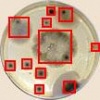This page is a part of CVprimer.com, a wiki devoted to computer vision. It focuses on low level computer vision, digital image analysis, and applications. It is designed as an online textbook but the exposition is informal. It geared towards software developers, especially beginners, and CS students. The wiki contains mathematics, algorithms, code examples, source code, compiled software, and some discussion. If you have any questions or suggestions, please contact me directly.
Main Page
From Computer Vision Primer
←Older revision | Newer revision→
|
Computer Vision For Beginners: A Developer’s Platform
The current image analysis and computer vision technology is a very large collection of disparate “tools” in the form of “toolboxes”, “cookbooks”, or code libraries. It follows the following outdated manual paradigm:
Image analysis tools include “edge detection”, “thresholding”, “segmentation”, “Fourier transform”, “wavelets”, "the Laplacian of the Gaussian" (my favorite), and on and on, all drown in a sea of image processing tools. It takes serious training and experience to put these pieces together. The methods are mathematically advanced at a level that goes well beyond what is covered in a typical undergraduate degree in computer science: Fourier and wavelet transforms, partial differential equations, probability and statistics, discrete topology and geometry, etc.
A computer vision platform should allow the software developer to concentrate on the user’s needs instead of custom development of or experimentation with mathematical methods and algorithms. Our goal is to take care of the "Mathematical tools" part above so that the developer would face this:
Initially we'll be able to handle only the fundamentals: objects in the image, their locations, measurements, their topology, etc. It is what may be called the low level computer vision. This data will allow the developer to concentrate on high level computer vision: what these objects represent in the context of his project.
For that we have our free software developer's kit (SDK). If you also want to understand how everything works, this wiki gives you a unique chance. We have complete and detailed expositions and source code.
In fact, this wiki is self-contained and requires only high school math...
How To Read This Wiki
The wiki contains 100 articles articles and there is a number of ways you can read it. Depending on your interests, this is how you can start. Each article has further links (UC stands for “under construction”).
If you are just curious about computer vision...
- Human vision vs. computer vision UC
- Case studies
- Overview
- Image search
- Binary images
- video/motion tracking UC
- Topological issues in computer vision
- Blog: Computer Vision for Dummies
If you are interested in photo editing etc...
- Image manipulation UC
- Image simplification - download
- Watercolors - download UC
- Binary images
- Grayscale images
- Color images UC
- Image search - download
- Mosaic making
If you are a scientist interested in image analysis for biology, medicine etc...
- Pixcavator tutorial - download
- Case studies
- Image analysis software
- Cell counting - download
- Binary images
If you are a student taking a computer vision class or image processing class...
Read the book assigned by your professor. Ignore this wiki if you want a good grade... (Unless you are one of my students, then proceed to The Mathematics of Computer Vision.)
If you are a beginner software developer interested in elementary computer vision...
- About this wiki
- Software projects
- Case studies
- Image segmentation
- Image analysis software
- Pixcavator tutorial - download
- Pixcavator SDK - download
- Binary images
- Binary images - implementation - download
- Grayscale images
If you are a software developer interested in advanced computer vision...
- About this wiki
- Overview
- Binary images
- Measuring objects
- Software projects
- Grayscale images
- Pixcavator SDK - download
- One-parameter images
- Color Images UC
- Fields related to computer vision
- Multi-parameter images
- Topological issues in computer vision
- Homology UC
If you are a computer vision researcher...
- Overview
- Related approaches
- Cell decomposition of images
- Binary images
- Grayscale images
- Topological issues in computer vision
- Homology UC
- Image Sequences
Also take a look at these slides:
Digital discoveries
- Casinos Not On Gamstop
- Non Gamstop Casinos
- Casino Not On Gamstop
- Casino Not On Gamstop
- Non Gamstop Casinos UK
- Casino Sites Not On Gamstop
- Siti Non Aams
- Casino Online Non Aams
- Non Gamstop Casinos UK
- UK Casino Not On Gamstop
- Non Gamstop Casino UK
- UK Casinos Not On Gamstop
- UK Casino Not On Gamstop
- Non Gamstop Casino UK
- Non Gamstop Casinos
- Non Gamstop Casino Sites UK
- Best Non Gamstop Casinos
- Casino Sites Not On Gamstop
- Casino En Ligne Fiable
- UK Online Casinos Not On Gamstop
- Online Betting Sites UK
- Meilleur Site Casino En Ligne
- Migliori Casino Non Aams
- Best Non Gamstop Casino
- Crypto Casinos
- Meilleur Site Casino En Ligne Belgique
- Bookmaker Non Aams
- онлайн казино с хорошей отдачей
- スマホ カジノ 稼ぐ
- Trang Web Cá độ Bóng đá Của Việt Nam












